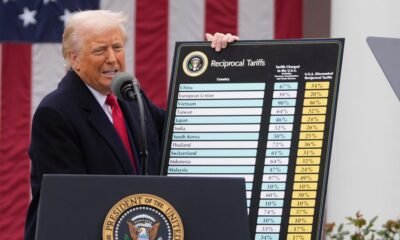Business
Trump Unveils Global Tariffs Amid Rising Concerns of Recession and Trade War

U.S. President Donald Trump has enacted a series of tariffs that could potentially set off a global recession and intensify trade conflicts among major economies. Dubbed “Liberation Day,” this move marks a continuation of Trump’s aggressive trade policies aimed at elevating America to a “manufacturing superpower.” Already, tariffs have been imposed on aluminum, steel, and automobiles.
In a bold declaration, Trump announced new tariffs targeting specific countries: a 20% tariff on European Union imports and a staggering 34% on Chinese goods, in addition to a general 10% tariff on all imports. This fulfills a long-standing campaign promise to fortify the U.S. economy with protective barriers not seen since the 1930s.
During a Rose Garden address, Trump proclaimed April 2, 2025, as a historic date for American industry. He accused nations, both allies and rivals, of exploiting the U.S. economically, stating, “For decades our country has been looted, pillaged, raped and plundered.” The economic ramifications of these tariffs have alarmed experts, who fear a derailment of the global commerce landscape.
Stock markets reacted negatively to the announcements, facing a staggering $5 trillion sell-off in the past six weeks. Analysts at Goldman Sachs have raised the probability of a recession to 35%, heightening concerns about the implications of Trump’s tariffs.
Responses from other major economies, including China, the EU, and Japan, predict a retaliatory stance against the U.S. tariffs. Many economists argue that Trump’s approach is misguided, as it disrupts established supply chains, leads to inflation, and threatens to increase unemployment rates. Concerns are mounting that these tariffs could provoke stagflation—a combination of stagnant economic growth and rising prices.
Mark Vail, a political economist at Wake Forest University, suggested that the forthcoming recession will be “self-inflicted,” with the administration likely underestimating the costs while overestimating the benefits of the tariffs. He indicated that consumer confidence is already dwindling and that Trump’s rural supporters could suffer significantly due to their reliance on exports.
Despite mounting criticism, Trump has positioned the tariffs as a necessary measure to protect American interests. He framed them as part of a broader strategy to revive the economy and restore American manufacturing. In a recent address, he acknowledged potential short-term pain but insisted that the long-term benefits will justify the costs.
Republican supporters have echoed Trump’s sentiments, with Senator Tim Sheehy of Montana drawing comparisons between the implementation of tariffs and the temporary discomfort of home renovations. However, economic data underscores the gravity of the situation. A report from the Yale Budget Lab predicted that the tariff proposals could result in a significant price increase for American households, with middle-income families facing losses of thousands of dollars annually.
Historical parallels to the U.S. tariffs have raised alarms about a similar downward spiral to that of the late 1920s and the Great Depression. In a time of economic uncertainty, Trump’s policies seem to challenge the foundations of a post-war system that governs international trade and monetary flow, potentially jeopardizing decades of established economic stability.


















